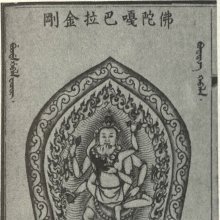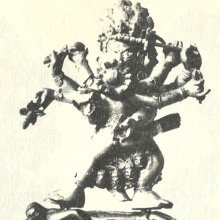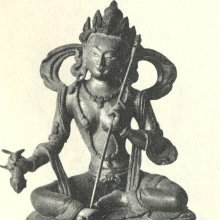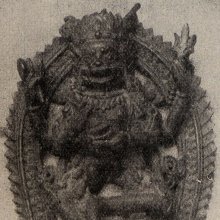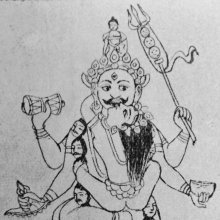Buddhakapala, Buddhakapāla: 2 definitions
Introduction:
Buddhakapala means something in Buddhism, Pali, Hinduism, Sanskrit. If you want to know the exact meaning, history, etymology or English translation of this term then check out the descriptions on this page. Add your comment or reference to a book if you want to contribute to this summary article.
Images (photo gallery)
In Buddhism
Tibetan Buddhism (Vajrayana or tantric Buddhism)
Source: archive.org: The Indian Buddhist IconographyBuddhakapāla (बुद्धकपाल) refers to one of the various emanations of Akṣobhya having their Sādhana described in the 5th-century Sādhanamālā (a collection of sādhana texts that contain detailed instructions for rituals).—His Colour is blue; his Āsana is dancing in ardhaparyaṅka; his Śakti is Citrasenā; he has four arms.—Only one sādhana gives the description of this god, who is, in all probability, another form of Heruka. The sādhana says that when Heruka is embraced by Citrasenā he gets the name of Buddhakapāla.
The Dhyāna (meditation instructions) of Buddhakapāla described in the Sādhanamālā as follows:
“The worshipper should think himself as (Buddhakapāla) who is a great hero, the supreme destroyer, of blue complexion and gigantic stature. He has ornaments of bones, stands in ardhaparyanka in a dancing attitude, is decked in garlands of heads, bears the effigy of Akṣobhya on the crown, is one-faced and four-armed. He carries the khaṭvāṅga and the kapāla in the left hands and the kartri and the ḍamaru in the right, and is embraced in the left by the Prajñā, Citrasenā by name, who is intoxicated, nude, and fearless, Thus meditating...”
The same Sādhana later on gives the details of the Maṇḍala, and goes on to say that Buddhakapāla is surrounded by twenty-four goddesses arranged in three circles:—
The first circle has: Sumālinī (blue) in the east, Kapālinī (yellow) in the north, Bhīmā (green) in the west and Durjayā (white) in the south.
The next circle has: Śubhamekhalā (east), Rūpiṇī (north), Jayā (west), Kauverī (south), Kāminī (north-east), Mahodadhī (north-west), Kāriṇī (south-west) and Māriṇī (south-east).
The outermost circle has: Bhīmadarśanā (east), Ajayā (north), Śubhā (west), Ostārakī (south), Surakṣiṇī (north-east), Vikālarātri (north-west), Mahāyaśā (south-west) and Sundari (south-east).
Besides these, there are the four guardians of gates: Sundarā (east), Subhagā (north), Priyadarśanā (west) and Nairātmā (south).
Excepting the four deities of the innermost circle, all the goddesses have blue colour two arms, one face, ornaments of bones, brown hair rising upwards but no garlands of heads. They carry the kapāla in the left and the kartri in the right, and dance in the ardhaparyaṅka attitude.

Tibetan Buddhism includes schools such as Nyingma, Kadampa, Kagyu and Gelug. Their primary canon of literature is divided in two broad categories: The Kangyur, which consists of Buddha’s words, and the Tengyur, which includes commentaries from various sources. Esotericism and tantra techniques (vajrayāna) are collected indepently.
Languages of India and abroad
Sanskrit dictionary
Source: Cologne Digital Sanskrit Dictionaries: Edgerton Buddhist Hybrid Sanskrit DictionaryBuddhakapāla (बुद्धकपाल).—name of a deity: Sādhanamālā 500.10; 503.9, 11.
Sanskrit, also spelled संस्कृतम् (saṃskṛtam), is an ancient language of India commonly seen as the grandmother of the Indo-European language family (even English!). Closely allied with Prakrit and Pali, Sanskrit is more exhaustive in both grammar and terms and has the most extensive collection of literature in the world, greatly surpassing its sister-languages Greek and Latin.
See also (Relevant definitions)
Full-text (+4): Sumalini, Durjaya, Kapalini, Bhima, Shubha, Ostaraki, Subhaga, Bhimadarshana, Ajaya, Shubhamekhala, Sundara, Sundari, Kamini, Karini, Mahayashas, Jaya, Mahodadhi, Priyadarshana, Marini, Vikalaratri.
Relevant text
Search found 3 books and stories containing Buddhakapala, Buddhakapāla; (plurals include: Buddhakapalas, Buddhakapālas). You can also click to the full overview containing English textual excerpts. Below are direct links for the most relevant articles:
The Indian Buddhist Iconography (by Benoytosh Bhattachacharyya)
Lakulisha-Pashupata (Philosophy and Practice) (by Geetika Kaw Kher)
A brief insight in Vajrayana Buddhism < [Chapter 2 - Spread and Transition]
Blue Annals (deb-ther sngon-po) (by George N. Roerich)
Chapter 1 - The Kashmirian Scholar Śākyaśrī < [Book 15 - Monastic Systems]
Chapter 29 - Sonam Gyatso (vii): Labors for the doctrine < [Book 10 - The Kālacakra]
Chapter 2 - The spread of explanations of Yoginī Tantras < [Book 4 - New Traditions of Secret Mantra]
Related products
